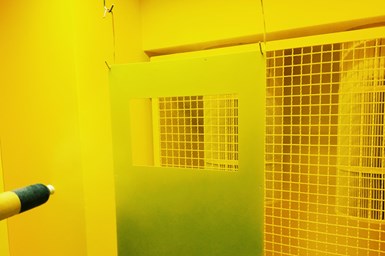Do You Have Good Ground?
John Cole, president of Parker Ionics, discusses his favorite subject: why having a good ground is so important for your powder coating process.

Q. I hear all the time that it is important to have a good ground when powder coating, but how come I can still powder coat even with what appears to be no, or little ground?
That’s an excellent question. I preach good ground whenever I can get anyone to listen to me and many times during the discussion someone will bring up the point that they can powder coat even though they know they have a terrible ground. And I always answer that this is true. Powder coating is a process where you can have everything going against you — poor ground, a bad powder gun, bad powder, moist compressed air — and you can still make the powder stick to metal. But, in those instances, you are not doing it effectively or efficiently. So, if cost and quality are not important to you, then by all means, keep doing what you are doing. But if you care about cutting material waste and costs and producing quality coated parts, keep reading.
Here’s what goes wrong with a poorly grounded part:
- Your transfer efficiency is greatly reduced. What does that mean? Essentially, it means it is costing you more to coat the part than it should. The electrostatic process involves impressing high voltage on the electrode of a powder gun. But that is only part of the process. Without an earth ground, or other ground, in close proximity of the electrode, current will not flow. Without current flow, there is no means to create ions. Without ions, there is nothing to charge the powder particles. Anything less than a solid earth ground is reducing the creation of ions and, in turn, reducing the number of ions present to charge powder particles.
- Film thickness varies significantly across different regions of the part. This phenomenon has been documented in several groundbreaking engineering studies. I’ve seen poorly grounded parts exhibit film thicknesses anywhere from under one mil up to and over seven mils on the same poorly grounded part. Don’t assume that this was operator error; these parts were coated on a conveyorized automatic powder line with quality guns with no operator present. Of course, you know that thin films will show the underlying metal and heavy film builds that exceed powder manufacturers’ specifications reduce most mechanical properties guaranteed by the powder manufacturer.
- Orange peel happens very quickly. With no path to ground, charged ions on powder particles and the always present excess free ions have nowhere to dissipate. Subsequently, they build up in large numbers on the part surface leading to back ionization.
- You increase the potential for booth fires. This is especially true for automatic powder coating booths. If the electrostatic energy built up on the ungrounded part happens to find a path to ground and it is within the spray pattern of the gun, the static discharge is known in some cases to have enough energy to ignite the powder cloud.
So how do I know if I have a ground problem?
Other than actually measuring the resistance of the part to a known earth ground, here are three telltale signs to watch out for:
- Does your hand turn the same color as the powder you are spraying? If so, this is proof positive that your part is poorly grounded. Your hand, holding the gun body (which is electrically grounded), presents a better ground than the ungrounded, or poorly grounded part. Powder follows that path.
- Do you hear a “snapping” noise while you are coating? This snapping noise is the result of the built-up ions on the part surface finally reaching a level that they will find a crack in the coating on hooks or some other point of ground and jump to it. If you look closely, you will see a bluish-white arc when this happens. Contrary to some comments I’ve heard, this is not an indication that your gun is charging properly.
- Excessive powder on the booth floor. Without a solid ground path, transfer efficiencies drop significantly, requiring higher gun outputs while depositing minimally more powder on the part. The rest of the powder goes on the floor or into the filters.
If you experience one or more of the above signs, it is time to take a serious look at what is wrong with your ground path. You may simply have dirty hooks and you need to strip them more often. There could be a breakdown in the ground path (due to broken wire, or a ground clip falling off); or it could be that your ground rod is placed in soil that presents a weak ground source. In any case, corrective action is required to improve your transfer efficiency and your coating quality.
A high-quality ground, in my opinion, is the single most important aspect of successful powder coating.
About the Author

John Cole
John Cole is president of Parker Ionics. Visit parkerionics.com
Related Content
3 Tests to Ensure Parts are Clean Prior to Plating
Making sure that all of the pre-processing fluids are removed prior to plating is not as simple as it seems. Rich Held of Haviland Products outlines three tests that can help verify that your parts are clean.
Read MoreCorrosion Resistance Testing for Powder Coating
Salt spray can be useful to help compare different pretreatment methods and coatings but it does not tell us much about the corrosion resistance of a part over time in the field. Powder coating expert Rodger Talbert offers insights into how to get a better idea of how to improve a part’s corrosion resistance in the real world.
Read MoreTrivalent Chrome Overview
As the finishing industry begins to move away from the use of hexavalent chromium to trivalent chromium, what factors should finishers consider as they make new investments? Mark Schario, chief technology officer for Columbia Chemical offers a helpful overview of this complicated topic.
Read MoreMasking Solutions for Medical Applications
According to Custom Fabricating and Supplies, a cleanroom is ideal for converting, die cutting, laminating, slitting, packaging and assembly of medical-grade products.
Read MoreRead Next
Truly Investing in Training
John Cole of powder coating equipment supplier Parker Ionics discusses how to get a worthwhile return on your investment in employee training.
Read MoreConsistency in Curing
Getting inconsistent results in your curing process? Verney Denerville of Tiger Drylac offers insights for achieving a proper powder coating cure every time.
Read MoreTGIC Powder Coatings vs. Non-TGIC Powder Coatings
As raw materials become increasingly scarce, powder coating consultant Rodger Talbert offers insights into using non-TGIC products.
Read More











.jpg;maxWidth=300;quality=90)









